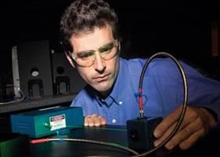Members Login

Channels
Special Offers & Promotions
Ocean Optics Adds New Triggering Options to USB2000+ Spectrometer
 Ocean Optics has added
triggering functions to its popular USB2000+ miniature spectrometer to provide
accurate timing and synchronization between the spectrometer and other devices.
Four low-jitter trigger modes and normal (free-running spectral acquisition)
operating modes are now possible. Applications include pulsing a light source
to occur when acquiring a spectra and synchronizing spectral acquisition to
coordinate with samples moving through a process stream or sensors reaching a
certain temperature level.
Ocean Optics has added
triggering functions to its popular USB2000+ miniature spectrometer to provide
accurate timing and synchronization between the spectrometer and other devices.
Four low-jitter trigger modes and normal (free-running spectral acquisition)
operating modes are now possible. Applications include pulsing a light source
to occur when acquiring a spectra and synchronizing spectral acquisition to
coordinate with samples moving through a process stream or sensors reaching a
certain temperature level. Triggering provides precise timing between devices. The USB2000+ can be triggered so that sending the spectrometer a pulse causes it to do something such as a turn off or on a light, activate a pulse in a pulsed light source or start or end spectral acquisition in the spectrometer. For example, in the USB2000+ External Triggering mode, an event outside the sampling system (such as a button push, lever activation or laser) electronically pulses the spectrometer's trigger pin and starts acquisition of the spectra with microsecond accuracy.
The USB2000+ has an onboard programmable high-speed FPGA controller, 22-pin connector and 8 user-programmable digital I/Os. Available operating modes are Normal (spectrometer continuously acquires spectra) and the four trigger modes:
- External Software Trigger. While the spectrometer is in free-running mode, data collected in the period up to the triggering event is transferred to software.
- External Hardware Level Trigger. The spectrometer waits for a sharp rise in voltage on the trigger input pin, and then acquires spectra until the voltage is removed.
- External Synchronous Trigger. Spectrometer acquires data from an external trigger event (such as a push button) until the next time the trigger is activated, at which time the spectrometer ceases spectral acquisition and begins a new acquisition. Integration time cannot be set, and is the effective period between triggers.
- External Hardware Edge Trigger. The spectrometer waits for a sharp rise in voltage on the trigger input pin, and then acquires one spectrum. One spectrum will be acquired for each trigger unless an acquisition is already in progress.
To learn more about USB2000+ triggering, visit www.OceanOptics.com, call Ocean Optics World Headquarters at +1 727-733-2447, or e-mail info@oceanoptics.com.
Media Partners


